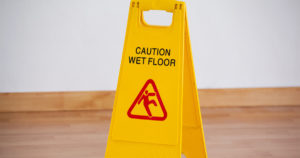Workplace Hazard: Deadly Falls
January 13, 2021 According to the Bureau of Labor Statistic’s (BLS) most recent workplace injury data, 880 workers died from slips, trips, and falls in 2019. Sadly, this number represents only a miniscule decrease from the year before. Fatal falls are second only to transportation incidents when it comes to the leading causes of deadly workplace accidents. The figures make it clear that not enough is being done to regulate and oversee workplace safety despite the fact that the failures involving known risks and hazards endanger workers every day.
According to the Bureau of Labor Statistic’s (BLS) most recent workplace injury data, 880 workers died from slips, trips, and falls in 2019. Sadly, this number represents only a miniscule decrease from the year before. Fatal falls are second only to transportation incidents when it comes to the leading causes of deadly workplace accidents. The figures make it clear that not enough is being done to regulate and oversee workplace safety despite the fact that the failures involving known risks and hazards endanger workers every day.
Unlike other types of injuries that all too commonly occur in the workplace, falls are the most likely to cause life-threatening complications. This is because falls can inflict injuries on the entire body, whereas other injuries tend to affect certain areas or body parts. According to the Occupational Safety and Health Administration (OSHA), workers who work at a height of six feet or higher (like on an elevated surface such as a scaffold, ladder, building, or roof) face particularly high occupational injury and death risks related to falls.
Common Fall Injuries
Some occupations incur higher fall risks than others, such as construction workers, roofers, transportation and warehouse workers, lift workers, electrical power line installers and repairers, and structural iron and steel workers. Falls from height frequently result in head, neck, and/or spinal injuries, like:
- Thoracic and lumbar spine fractures
- Lower and upper limb fractures
- Pelvic injuries
- Traumatic brain injuries or TBIs, skull fractures, and other types of head injuries
- Cervical spine, or neck, fractures
Almost every serious or fatal fall from height is preventable. If an employer fails to recognize and address known hazards or a manufacturer produces unsafe items, however, it directly jeopardizes the safety of all workers.
Fall Protection
OSHA first partnered with the National Institute for Occupational Safety and Health (NIOSH) and the National Occupational Research Agenda, or NORA, in 2012 to promote awareness among employers and workers about common fall hazards and how to best prevent them from leading to serious injury or death. OSHA’s recommendations for reducing occupational fall risks and associated injuries is three-fold:
- Always plan a job ahead. Employers need to plan projects ahead to ensure that they can be carried out in a safe manner. One of the most critical parts of this planning process is to determine how a job will be done, what tasks it involves, and what safety equipment is necessary in order to complete each task safely. Employers must consider job and project-specific hazards. For example, roofing jobs come with fall risks like holes, leading edges, and skylights
- Provide workers with the right equipment to keep them safe. Employers must provide workers with fall protection that is appropriate for the job at hand. This includes providing the correct scaffolds, ladders, and personal protective equipment (PPE), like personal fall arrest systems or PFAS’ and safety harnesses for anchoring
- Train every employee on how to use industrial equipment safely and correctly. Not only do workers need to receive equipment training that includes teaching them how to properly set up and use the equipment, but they also require training on ways to recognize and report jobsite hazards
Workers’ Compensation and Third Party Fall Claims
Some falls that cause serious injury or death are the result of various personal protective equipment or industrial structure failures, like unsafely or defectively designed personal protective equipment, scaffolding, ladders, boom, aerial or scissor lifts, or other products that are frequently used to work at height. In these instances, injured workers not only have the right to file a workers’ compensation claim but also a third party claim. Unlike workers’ compensation, which is a type of insurance that pays medical benefits and wage replacement to workers who were injured due to their employer’s negligence and failure to provide a safe and healthful workplace, third party claims are typically lodged against a manufacturer of defective equipment.
Just like employers are legally obligated to provide a workplace free from known and recognizable hazards, equipment manufacturers suppliers, and sellers have the duty to manufacture, supply, and sell equipment in a safe condition or a condition safe for all foreseeable uses. When a manufacturer or employer is negligent and it leads to a worker being injured in a fall from a height, the injured party has a right to file a workers’ compensation and/or a third party claim. If you would like to learn more about filing a claim or want to speak with an attorney about being injured at work, contact a representative online now.
Philadelphia Personal Injury Lawyers at Galfand Berger, LLP Representing Injured Workers Since 1947
With offices located in Philadelphia, Bethlehem, Reading and Lancaster, Galfand Berger LLP serves clients throughout Pennsylvania and New Jersey. To schedule a consultation, call us at 800-222-8792 or complete our online contact form.
 Google Screened
Google Screened
